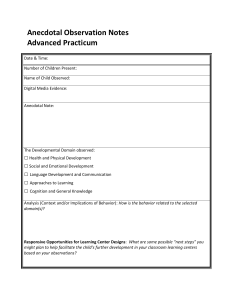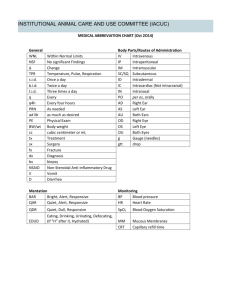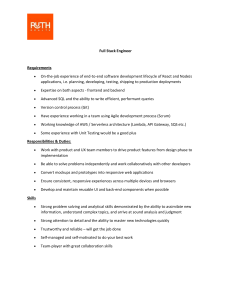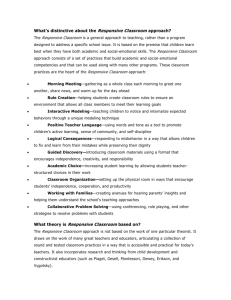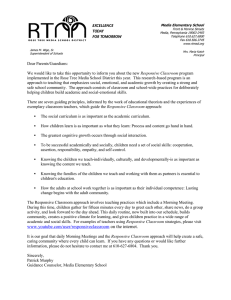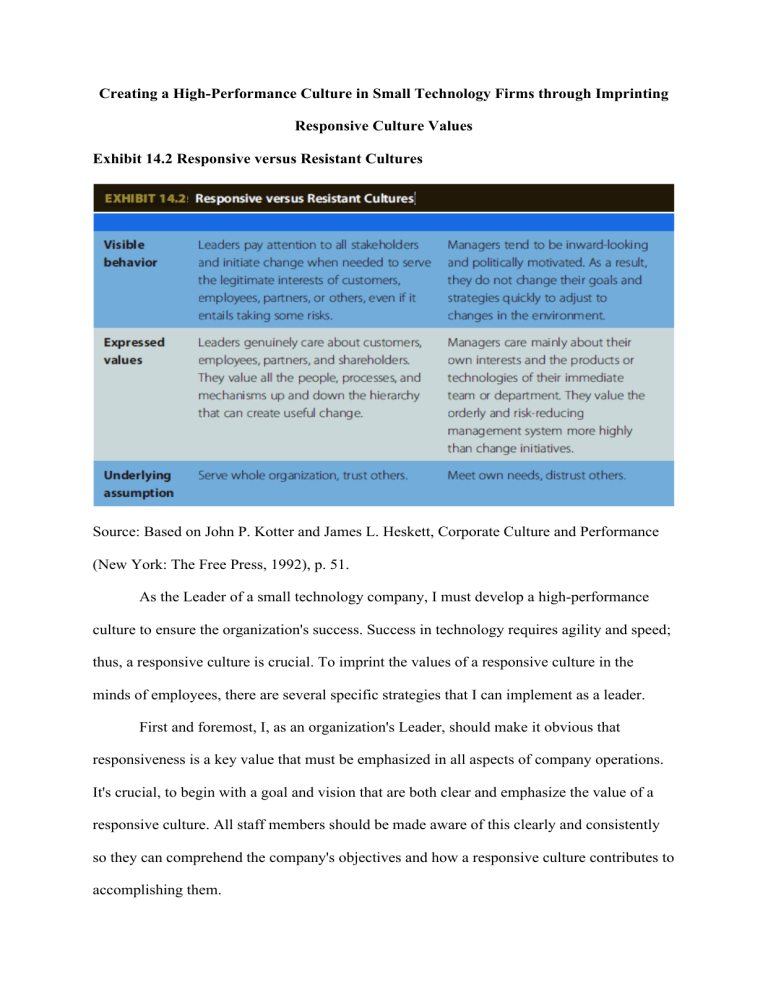
Creating a High-Performance Culture in Small Technology Firms through Imprinting Responsive Culture Values Exhibit 14.2 Responsive versus Resistant Cultures Source: Based on John P. Kotter and James L. Heskett, Corporate Culture and Performance (New York: The Free Press, 1992), p. 51. As the Leader of a small technology company, I must develop a high-performance culture to ensure the organization's success. Success in technology requires agility and speed; thus, a responsive culture is crucial. To imprint the values of a responsive culture in the minds of employees, there are several specific strategies that I can implement as a leader. First and foremost, I, as an organization's Leader, should make it obvious that responsiveness is a key value that must be emphasized in all aspects of company operations. It's crucial, to begin with a goal and vision that are both clear and emphasize the value of a responsive culture. All staff members should be made aware of this clearly and consistently so they can comprehend the company's objectives and how a responsive culture contributes to accomplishing them. As a Leader, I need to set a good example as leaders must set an example for the attitudes and values they want their team to possess in order to develop a responsive culture. Keeping in mind that responding swiftly and effectively to any requests or complaints is a priority in dealings with clients and team members. Employees will learn that timeliness is a major priority from this, setting the tone for the rest of the organization. Feedback is a crucial component of developing a high-performance culture. A feedbackfriendly culture promotes candid communication and supports pinpointing areas that require improvement. Leaders must create a climate where expressing opinions is perceived to be safe (Thorgren & Caiman, 2019). I would develop a culture where team members are open to providing and accepting feedback. Regular check-ins and performance evaluations can help pinpoint problem areas and promote accountability. To foster a two-way conversation that encourages continual growth, I would also be receptive to feedback from the team members. An engaged employee is aware of the business context and works with colleagues to improve job performance for the organization's benefit. The organization must work to develop and nurture engagement, which requires a two-way relationship between employer and employee (Nayak et al., 2020). To develop a responsive culture, employees must be empowered. Employees must take responsibility for their work and be proactive in finding and resolving issues in order to operate in a high-performance culture. To do so, I would encourage this by empowering employees to make decisions and take on responsibility. This entails giving them the resources and assistance they need and the freedom to choose their own course of action. Building the abilities and knowledge required for a high-performance culture also requires investing in training and development. Employees should have access to tools and opportunities, such as workshops or online courses, to develop new skills. Employees will benefit from staying current on trends and technology, and this will guarantee that they are prepared to meet the organization's and client's changing needs. Making an environment that promotes psychological safety is another crucial component of developing a responsive culture. This entails developing a culture in which team members are at ease taking chances, contributing ideas, and displaying vulnerability. Team members are more likely to take responsibility for their work and be responsive to client needs when they feel comfortable expressing their opinions and feelings. Underlying assumptions are the beliefs and attitudes that shape behavior and decisionmaking. Any underlying assumptions that might be impeding responsiveness should be recognized and challenged to develop a high-performance culture. For instance, if it is believed that "excellent work takes time," this may result in a culture where perfectionism takes precedence over expediency. As a leader, I can influence a change in the culture toward responsiveness by challenging this presumption and highlighting the value of speed and agility. Finally, it is critical to celebrate successes and recognize employees who embody the values of a responsive culture in order to reinforce those values. Bonuses, recognition programs, and other incentives may be included. I would make it a point to recognize and celebrate team members' achievements and milestones. Conclusion To summarise, a leader must be intentional about promoting visible behavior, expressing values that resonate with employees, challenging underlying assumptions, aligning systems and processes, creating psychological safety, promoting continuous learning and improvement, and celebrating successes in order to create a high-performance culture. With this, I, as a leader, can imprint the values of a responsive culture in the minds of the employees by implementing these strategies, resulting in a culture that prioritizes speed, agility, and proactive problem-solving. Reference Daft, Richard L. (2018). The Leadership Experience (7th ed.). Cengage. Nayak, B. C., Nayak, G. K., & Jena, D. (2020). Social recognition and employee engagement: The effect of social media in organizations. International Journal of Engineering Business Management, 12, 184797902097510. https://doi.org/10.1177/1847979020975109 Thorgren, S., & Caiman, E. (2019). The Role of Psychological Safety in Implementing Agile Methods across Cultures. Research-Technology Management, 62(2), 31–39. https://doi.org/10.1080/08956308.2019.1563436

